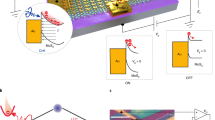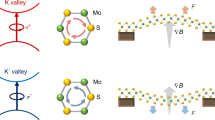Abstract
The valley degree of freedom1,2,3,4 of electrons in materials promises routes towards energy-efficient information storage with enticing prospects for quantum information processing5,6,7. Current challenges in utilizing valley polarization are symmetry conditions that require monolayer structures8,9 or specific material engineering10,11,12,13, non-resonant optical control to avoid energy dissipation and the ability to switch valley polarization at optical speed. We demonstrate all-optical and non-resonant control over valley polarization using bulk MoS2, a centrosymmetric material without Berry curvature at the valleys. Our universal method utilizes spin angular momentum-shaped trefoil optical control pulses14,15 to switch the material’s electronic topology and induce valley polarization by transiently breaking time and space inversion symmetry16 through a simple phase rotation. We confirm valley polarization through the transient generation of the second harmonic of a non-collinear optical probe pulse, depending on the trefoil phase rotation. The investigation shows that direct optical control over the valley degree of freedom is not limited to monolayer structures. Indeed, such control is possible for systems with an arbitrary number of layers and for bulk materials. Non-resonant valley control is universal and, at optical speeds, unlocks the possibility of engineering efficient multimaterial valleytronic devices operating on quantum coherent timescales.
This is a preview of subscription content, access via your institution
Access options
Access Nature and 54 other Nature Portfolio journals
Get Nature+, our best-value online-access subscription
$29.99 / 30 days
cancel any time
Subscribe to this journal
Receive 51 print issues and online access
$199.00 per year
only $3.90 per issue
Buy this article
- Purchase on Springer Link
- Instant access to full article PDF
Prices may be subject to local taxes which are calculated during checkout




Similar content being viewed by others
Data availability
All data supporting the study are available as source data and with the responding data processing scripts on https://github.com/jbiegert/ICFO-AUO-Valleytronics. All parameters necessary to reproduce the calculations are given in Methods and Supplementary Information. This information and ref. 16 provide the necessary details for a researcher to run IWERIA, or to develop a similar code. Further details on request.
Code availability
Three numerical codes were used in this work: Quantum Espresso40, Wannier90 (ref. 41) and IWERIA16. The first two are open-source and can be found at https://www.quantum-espresso.org/ and https://wannier.org/, respectively. IWERIA is an in-house code and parts of it relevant to reproducing the results of this work can be made available from the corresponding author upon request. All scripts can be found under https://github.com/jbiegert/ICFO-AUO-Valleytronics.
References
Yao, W., Xiao, D. & Niu, Q. Valley-dependent optoelectronics from inversion symmetry breaking. Phys. Rev. B 77, 235406 (2008).
Vitale, S. A. et al. Valleytronics: opportunities, challenges, and paths forward. Small 14, 1801483 (2018).
Schaibley, J. R. et al. Valleytronics in 2D materials. Nat. Rev. Mater. 1, 16055 (2016).
Liu, Y. et al. Valleytronics in transition metal dichalcogenides materials. Nano Res. 12, 2695–2711 (2019).
Culcer, D., Saraiva, A. L., Koiller, B., Hu, X. & Das Sarma, S. Valley-based noise-resistant quantum computation using Si quantum dots. Phys. Rev. Lett. 108, 126804 (2012).
Rohling, N. & Burkard, G. Universal quantum computing with spin and valley states. New J. Phys. 14, 083008 (2012).
Gunawan, O., Habib, B., De Poortere, E. P. & Shayegan, M. Quantized conductance in an AlAs two-dimensional electron system quantum point contact. Phys. Rev. B 74, 155436 (2006).
Zeng, H., Dai, J., Yao, W., Xiao, D. & Cui, X. Valley polarization in MoS2 monolayers by optical pumping. Nat. Nanotechnol. 7, 490–493 (2012).
Mak, K. F., He, K., Shan, J. & Heinz, T. F. Control of valley polarization in monolayer MoS2 by optical helicity. Nat. Nanotechnol. 7, 494–498 (2012).
Song, Y., Zhai, F. & Guo, Y. Generation of a fully valley-polarized current in bulk graphene. Appl. Phys. Lett. 103, 183111 (2013).
Yin, J. et al. Tunable and giant valley-selective Hall effect in gapped bilayer graphene. Science 375, 1398–1402 (2022).
Suzuki, R. et al. Valley-dependent spin polarization in bulk MoS2 with broken inversion symmetry. Nat. Nanotechnol. 9, 611–617 (2014).
Xia, J. et al. Valley polarization in stacked MoS2 induced by circularly polarized light. Nano Res. 10, 1618–1626 (2017).
Milošević, D. B., Becker, W. & Kopold, R. Generation of circularly polarized high-order harmonics by two-color coplanar field mixing. Phys. Rev. A 61, 063403 (2000).
Mitra, S. et al. Light-wave-controlled Haldane model in monolayer hexagonal boron nitride. Nature https://doi.org/10.1038/s41586-024-07244-z (2024).
Jiménez-Galán, Á., Silva, R. E. F., Smirnova, O. & Ivanov, M. Lightwave control of topological properties in 2D materials for sub-cycle and non-resonant valley manipulation. Nat. Photon. 14, 728–732 (2020).
Goulielmakis, E. et al. Attosecond control and measurement: lightwave electronics. Science 317, 769–775 (2007).
Garg, M. et al. Multi-petahertz electronic metrology. Nature 538, 359–363 (2016).
Mashiko, H., Oguri, K., Yamaguchi, T., Suda, A. & Gotoh, H. Petahertz optical drive with wide-bandgap semiconductor. Nat. Phys. 12, 741–745 (2016).
Reimann, J. et al. Subcycle observation of lightwave-driven Dirac currents in a topological surface band. Nature 562, 396–400 (2018).
Baudisch, M. et al. Ultrafast nonlinear optical response of Dirac fermions in graphene. Nat. Commun. 9, 1–6 (2018).
Cao, T. et al. Valley-selective circular dichroism of monolayer molybdenum disulphide. Nat. Commun. 3, 887 (2012).
Jones, A. M. et al. Optical generation of excitonic valley coherence in monolayer WSe2. Nat. Nanotechnol. 8, 634–638 (2013).
Gunlycke, D. & White, C. T. Graphene valley filter using a line defect. Phys. Rev. Lett. 106, 136806 (2011).
Xiao, D., Liu, G.-B., Feng, W., Xu, X. & Yao, W. Coupled spin and valley physics in monolayers of MoS2 and other group-VI dichalcogenides. Phys. Rev. Lett. 108, 196802 (2012).
Mrudul, M. S., Jiménez-Galán, Á., Ivanov, M. & Dixit, G. Light-induced valleytronics in pristine graphene. Optica 8, 422–427 (2021).
Rivera, P. et al. Valley-polarized exciton dynamics in a 2D semiconductor heterostructure. Science 351, 688–691 (2016).
Holler, J. et al. Interlayer exciton valley polarization dynamics in large magnetic fields. Phys. Rev. B 105, 085303 (2022).
Brandão, D. S. et al. Phonon-fostered valley polarization of interlayer excitons in van der Waals heterostructures. J. Phys. Chem. C 126, 18128–18138 (2022).
Elu, U. et al. Seven-octave high-brightness and carrier-envelope-phase-stable light source. Nat. Photon. 15, 277–280 (2021).
Ghimire, S. et al. Observation of high-order harmonic generation in a bulk crystal. Nat. Phys. 7, 138–141 (2011).
You, Y. S., Reis, D. A. & Ghimire, S. Anisotropic high-harmonic generation in bulk crystals. Nat. Phys. 13, 345–349 (2017).
Vampa, G. et al. Theoretical analysis of high-harmonic generation in solids. Phys. Rev. Lett. 113, 073901–073901 (2014).
Hohenleutner, M. et al. Real-time observation of interfering crystal electrons in high-harmonic generation. Nature 523, 572–575 (2015).
Luu, T. T. et al. Extreme ultraviolet high-harmonic spectroscopy of solids. Nature 521, 498–502 (2015).
Uzan, A. J. et al. Attosecond spectral singularities in solid-state high-harmonic generation. Nat. Photon. 14, 183–187 (2020).
Heinrich, T. et al. Chiral high-harmonic generation and spectroscopy on solid surfaces using polarization-tailored strong fields. Nat. Commun. 12, 3723 (2021).
Baykusheva, D. & Wörner, H. J. Chiral discrimination through bielliptical high-harmonic spectroscopy. Phys. Rev. X 8, 031060 (2018).
Klemke, N. et al. Polarization-state-resolved high-harmonic spectroscopy of solids. Nat. Commun. 10, 1319 (2019).
Giannozzi, P. et al. QUANTUM ESPRESSO: a modular and open-source software project for quantum simulations of materials. J. Phys. Condens. Matter 21, 395502 (2009).
Pizzi, G. et al. Wannier90 as a community code: new features and applications. J. Phys. Condens. Matter 32, 165902 (2020).
Jiménez-Galán, Á., Zhavoronkov, N., Schloz, M., Morales, F. & Ivanov, M. Time-resolved high harmonic spectroscopy of dynamical symmetry breaking in bi-circular laser fields: the role of Rydberg states. Opt. Express 25, 22880 (2017).
Eichmann, H. et al. Polarization-dependent high-order two-color mixing. Phys. Rev. A 51, 3414–3417 (1995).
Kong, F. et al. Spin-constrained orbital-angular-momentum control in high-harmonic generation. Phys. Rev. Res. 1, 032008 (2019).
Acknowledgements
J.B. acknowledges financial support from the European Research Council for ERC Advanced Grant “TRANSFORMER” (788218), ERC Proof of Concept Grant “miniX” (840010), FET-OPEN “PETACom” (829153), FET-OPEN “OPTOlogic” (899794), FET-OPEN “TwistedNano” (101046424), Laserlab-Europe (871124), MINECO for Plan Nacional PID2020–112664GB-I00; AGAUR for SGR-2021-01449, MINECO for “Severo Ochoa” (CEX2019-000910-S), Fundació Cellex Barcelona, the CERCA Programme/Generalitat de Catalunya and the Alexander von Humboldt Foundation for the Friedrich Wilhelm Bessel Prize. I.T. and J.B. acknowledge support from Marie Skłodowska-Curie ITN “smart-X” (860553). A.J.-G. acknowledges support from the Comunidad de Madrid through the Talento Grant 2022-T1/IND-24102 and from the EU Marie Skłodowska-Curie Global Fellowship (101028938). R. S. acknowledges support from Grant No. PID2021-122769NB-I00 funded by MCIN/AEI and from the fellowship LCF/BQ/PR21/11840008 from “La Caixa” Foundation (ID 100010434). M.I. acknowledges support from FET-OPEN “OPTOlogic” (899794). M.I. also acknowledges the Limati SFB 1777 “Light–matter interaction at interfaces” project, award number 441234705. O.S. acknowledges funding from the European Union (ERC ULISSES, award number 101054696). We thank Ryo Mizuta Graphics for their 3D assets. We also thank U. Elu, M. Enders and L. Maidment for their assistance.
Author information
Authors and Affiliations
Contributions
J.B. conceived the project. I.T., J.P. and L.V. performed the experiments with support from J.B. I.T. prepared the sample and analysed experimental data with support from J.B. and L.V. A.J.-G. performed the calculations with support from R.F.S., M.I. and O.S. A.J.-G., R.F.S., M.I. and O.S. analysed theory data. R.S. developed the numerical code. F.T. and P.St.J.R. supplied the ARR-PCF. J.B. wrote the manuscript with I.T. and input from all authors.
Corresponding author
Ethics declarations
Competing interests
The authors declare no competing interests.
Peer review
Peer review information
Nature thanks Dong Sun and the other, anonymous, reviewer(s) for their contribution to the peer review of this work. Peer reviewer reports are available.
Additional information
Publisher’s note Springer Nature remains neutral with regard to jurisdictional claims in published maps and institutional affiliations.
Extended data figures and tables
Extended Data Fig. 1 Polarization scans for linear, circular and trefoil driving fields.
Harmonic spectra from GaSe are recorded as a function of the crystal rotation angle.
Extended Data Fig. 2 Trefoil selection rules from two-colour mixing of pump photons with opposite spin-angular momentum.
Right, simulated pump spectra for perfect and experimental ellipticity of the pump colours. Maximal suppression of 3 N harmonics is observed for perfectly circular 3.2 µm + 1.6 µm. Imperfect ellipticity leads to a detectable 3 N harmonic signal, meanwhile suppression reduces with harmonic orders approaching the cut-off.
Extended Data Fig. 3 Probe second harmonic signal’s dependency on the pump trefoil rotation, analysed through Fast Fourier Transform.
Clear modulation with 60° periodicity appears in the power spectral density (PSD) during strong field excitation (green) following the six-fold symmetry of the 2H-MoS2 sample.
Extended Data Fig. 4 DFT-calculated bilayer MoS2.
a, Crystal structure. b, First Brillouin zone. c, Band structure obtained by projecting onto the d orbitals of Mo and the p orbitals of S. Red (blue) dispersion curves indicate the ground state fully-filled (empty) valence (conduction) bands.
Supplementary information
Supplementary Information
Supplementary Notes 1–3, Figs 1–6 and References.
Rights and permissions
Springer Nature or its licensor (e.g. a society or other partner) holds exclusive rights to this article under a publishing agreement with the author(s) or other rightsholder(s); author self-archiving of the accepted manuscript version of this article is solely governed by the terms of such publishing agreement and applicable law.
About this article
Cite this article
Tyulnev, I., Jiménez-Galán, Á., Poborska, J. et al. Valleytronics in bulk MoS2 with a topologic optical field. Nature 628, 746–751 (2024). https://doi.org/10.1038/s41586-024-07156-y
Received:
Accepted:
Published:
Issue Date:
DOI: https://doi.org/10.1038/s41586-024-07156-y
Comments
By submitting a comment you agree to abide by our Terms and Community Guidelines. If you find something abusive or that does not comply with our terms or guidelines please flag it as inappropriate.



